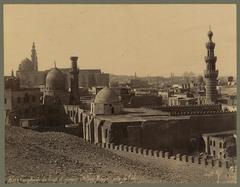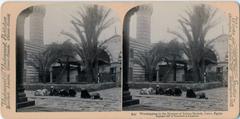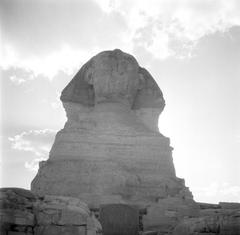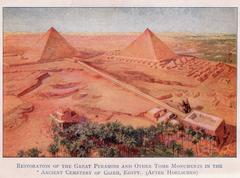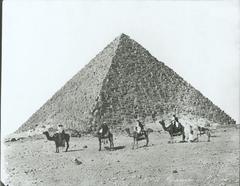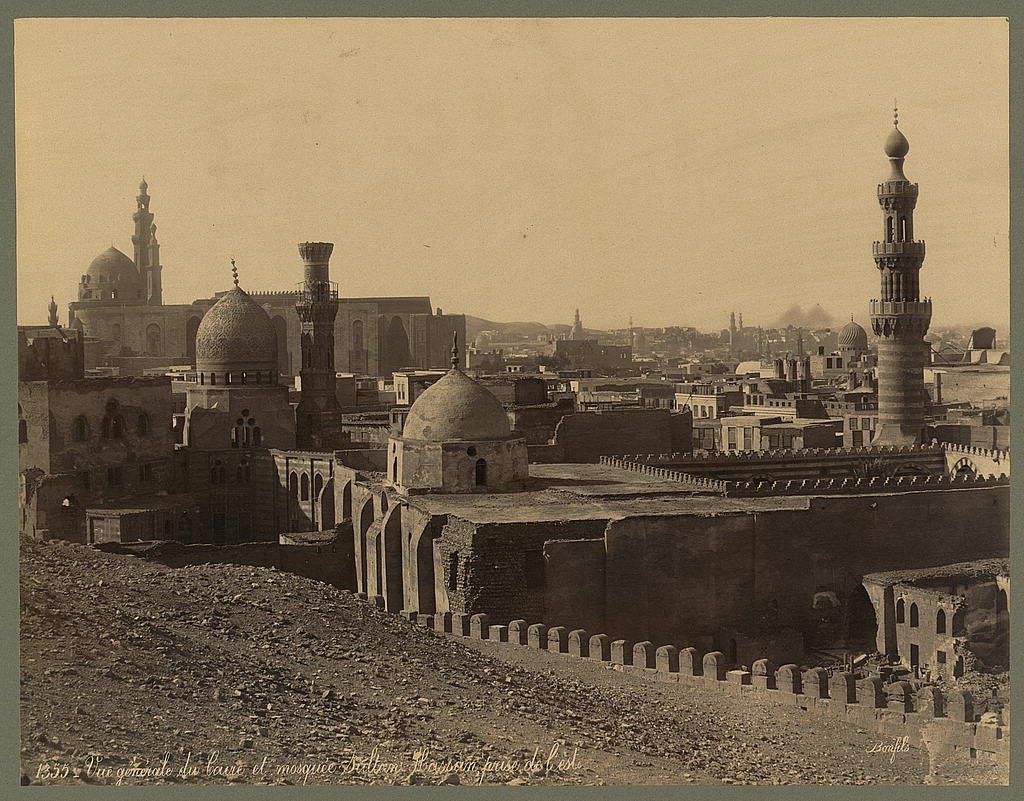
The Ultimate Guide to Visiting the Blue Mosque in Giza
Date: 23/07/2024
Introduction
The Blue Mosque, or المسجد الأزرق, is a captivating historical and architectural marvel located in Giza, Egypt. Known for its extensive use of blue tiles that adorn its interior and exterior surfaces, the mosque is a testament to the rich cultural and artistic heritage of the Mamluk Sultanate. Commissioned by Sultan Al-Nasir Muhammad and constructed between 1347 and 1350, the Blue Mosque stands as a symbol of Islamic architectural brilliance (source). This guide aims to provide a comprehensive overview of the mosque’s history, architectural features, cultural significance, and essential visitor information, making it an indispensable resource for history buffs, architecture enthusiasts, and travelers alike.
Table of Contents
- Introduction
- Origins and Construction
- Architectural Significance
- Historical Events and Renovations
- Cultural and Religious Significance
- Visitor Information
- Nearby Attractions
- Preservation and Tourism
- Notable Features and Artifacts
- FAQ Section
- Conclusion
- Sources
Origins and Construction
The Blue Mosque, also known as المسجد الأزرق, is a significant historical and architectural landmark located in Giza, Egypt. Its construction dates back to the early 14th century during the Mamluk Sultanate, a period marked by the flourishing of Islamic art and architecture. The mosque was commissioned by Sultan Al-Nasir Muhammad, who ruled Egypt three times between 1293 and 1341. The construction of the mosque began in 1347 and was completed in 1350. The mosque’s name, “Blue Mosque,” is derived from the extensive use of blue tiles that adorn its interior and exterior surfaces.
Architectural Significance
The architectural design of the Blue Mosque is a testament to the Mamluk style, characterized by its intricate geometric patterns, calligraphy, and the use of luxurious materials. The mosque features a large central dome, flanked by smaller domes, and a spacious courtyard surrounded by arcades. The minaret, a prominent feature of the mosque, stands tall and is adorned with intricate carvings and inscriptions.
One of the most striking features of the Blue Mosque is its extensive use of blue and turquoise tiles, which cover the walls, mihrab (prayer niche), and minbar (pulpit). These tiles were imported from Persia, reflecting the cultural and artistic exchanges between the Mamluk Sultanate and other Islamic regions. The use of these tiles not only adds to the aesthetic appeal of the mosque but also signifies the importance of the color blue in Islamic art, symbolizing spirituality and the heavens.
Historical Events and Renovations
Throughout its history, the Blue Mosque has witnessed numerous historical events and undergone several renovations. During the Ottoman period, the mosque continued to serve as a significant religious and cultural center. However, it suffered damage during the French invasion of Egypt in 1798, led by Napoleon Bonaparte. The mosque was partially restored in the early 19th century under the reign of Muhammad Ali Pasha, who sought to revive and preserve Egypt’s Islamic heritage.
In the 20th century, the mosque underwent further restoration efforts to address structural issues and preserve its historical and architectural integrity. These efforts were supported by both the Egyptian government and international organizations dedicated to the preservation of cultural heritage. The most recent restoration project, completed in 2018, focused on reinforcing the mosque’s foundations, cleaning and repairing the blue tiles, and restoring the intricate carvings and inscriptions.
Cultural and Religious Significance
The Blue Mosque holds immense cultural and religious significance for both the local Muslim community and visitors from around the world. As a place of worship, it continues to serve as a center for daily prayers, Friday congregational prayers, and special religious events such as Ramadan and Eid celebrations. The mosque’s serene and spiritual atmosphere attracts worshippers and visitors seeking a place for reflection and prayer.
In addition to its religious functions, the Blue Mosque is also a symbol of Egypt’s rich Islamic heritage and architectural prowess. It stands as a testament to the artistic and cultural achievements of the Mamluk period and serves as an important educational resource for scholars, historians, and students of Islamic art and architecture. The mosque’s unique blend of architectural styles and decorative elements provides valuable insights into the cultural exchanges and influences that shaped the Islamic world during the medieval period.
Visitor Information
Visiting Hours and Tickets
The Blue Mosque is open to visitors daily from 9:00 AM to 5:00 PM, except during special religious events when visiting hours may vary. It is advisable to check the official website or contact the mosque directly for the most up-to-date information. Entry to the Blue Mosque is free for all visitors, but donations are welcome and go towards the maintenance and preservation of the mosque.
Dress Code
Visitors are required to dress modestly. Women should cover their heads, and both men and women should wear clothing that covers their arms and legs.
Photography
Photography is allowed, but it is respectful to avoid taking photos during prayer times.
Best Time to Visit
Early mornings or late afternoons are ideal times to visit to avoid the crowds and experience the mosque’s serene atmosphere.
Nearby Attractions
While visiting the Blue Mosque, take the opportunity to explore other nearby attractions in Giza:
- The Great Sphinx of Giza: A short drive from the mosque, this iconic limestone statue is one of Egypt’s most famous landmarks.
- Giza Plateau: Home to the Pyramids of Giza, including the Great Pyramid of Khufu, the Giza Plateau offers a glimpse into ancient Egyptian civilization.
- Solar Boat Museum: Located near the Great Pyramid, this museum houses the reconstructed solar boat of Pharaoh Khufu, an ancient Egyptian artifact of great significance.
Preservation and Tourism
The preservation of the Blue Mosque is of paramount importance to ensure that future generations can continue to appreciate its historical and cultural significance. The mosque is managed by the Egyptian Ministry of Antiquities, which oversees its maintenance and restoration efforts. The ministry collaborates with international organizations such as UNESCO to secure funding and expertise for ongoing preservation projects.
Tourism plays a crucial role in supporting the preservation of the Blue Mosque. The mosque is a popular destination for tourists visiting Giza, who are drawn to its stunning architecture and historical significance. To accommodate the influx of visitors, the mosque has implemented measures to ensure that tourism does not compromise its structural integrity or spiritual atmosphere. These measures include guided tours, designated visitor hours, and educational programs that highlight the mosque’s history and cultural importance.
Notable Features and Artifacts
The Blue Mosque houses several notable features and artifacts that contribute to its historical and cultural significance. Among these are the intricately carved wooden minbar, which dates back to the mosque’s original construction and is considered a masterpiece of Mamluk woodworking. The mihrab, adorned with blue and turquoise tiles and intricate calligraphy, is another focal point of the mosque’s interior.
The mosque also contains a collection of historical manuscripts and religious texts, some of which date back to the Mamluk and Ottoman periods. These manuscripts provide valuable insights into the religious, cultural, and intellectual life of the time and are preserved in a dedicated library within the mosque complex.
FAQ Section
Q: What are the visiting hours for the Blue Mosque? A: The Blue Mosque is open daily from 9:00 AM to 5:00 PM, except during special religious events.
Q: Is there an entry fee for the Blue Mosque? A: Entry is free, but donations are welcome.
Q: Are there any dress code requirements for visitors? A: Yes, visitors should dress modestly. Women should cover their heads, and both men and women should wear clothing that covers their arms and legs.
Q: Can I take photographs inside the Blue Mosque? A: Photography is allowed, but it is respectful to avoid taking photos during prayer times.
Conclusion
The Blue Mosque in Giza is not merely a place of worship but a beacon of Egypt’s Islamic heritage and architectural excellence. Its rich history, from its Mamluk origins to its recent restorations, underscores its enduring cultural and religious significance (source). Visitors are drawn to its stunning blue tiles, intricate carvings, and the serene atmosphere that offers a space for reflection and prayer. By preserving this historical site and promoting respectful tourism, we ensure that the legacy of the Blue Mosque continues to inspire future generations. Plan your visit to this mesmerizing landmark to immerse yourself in a unique blend of history, art, and spirituality.
